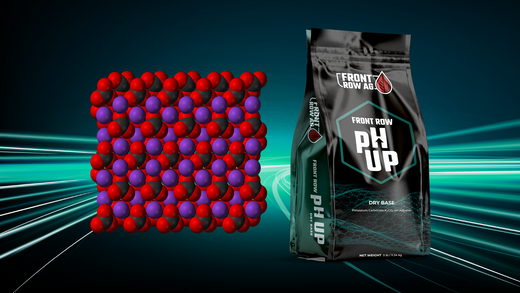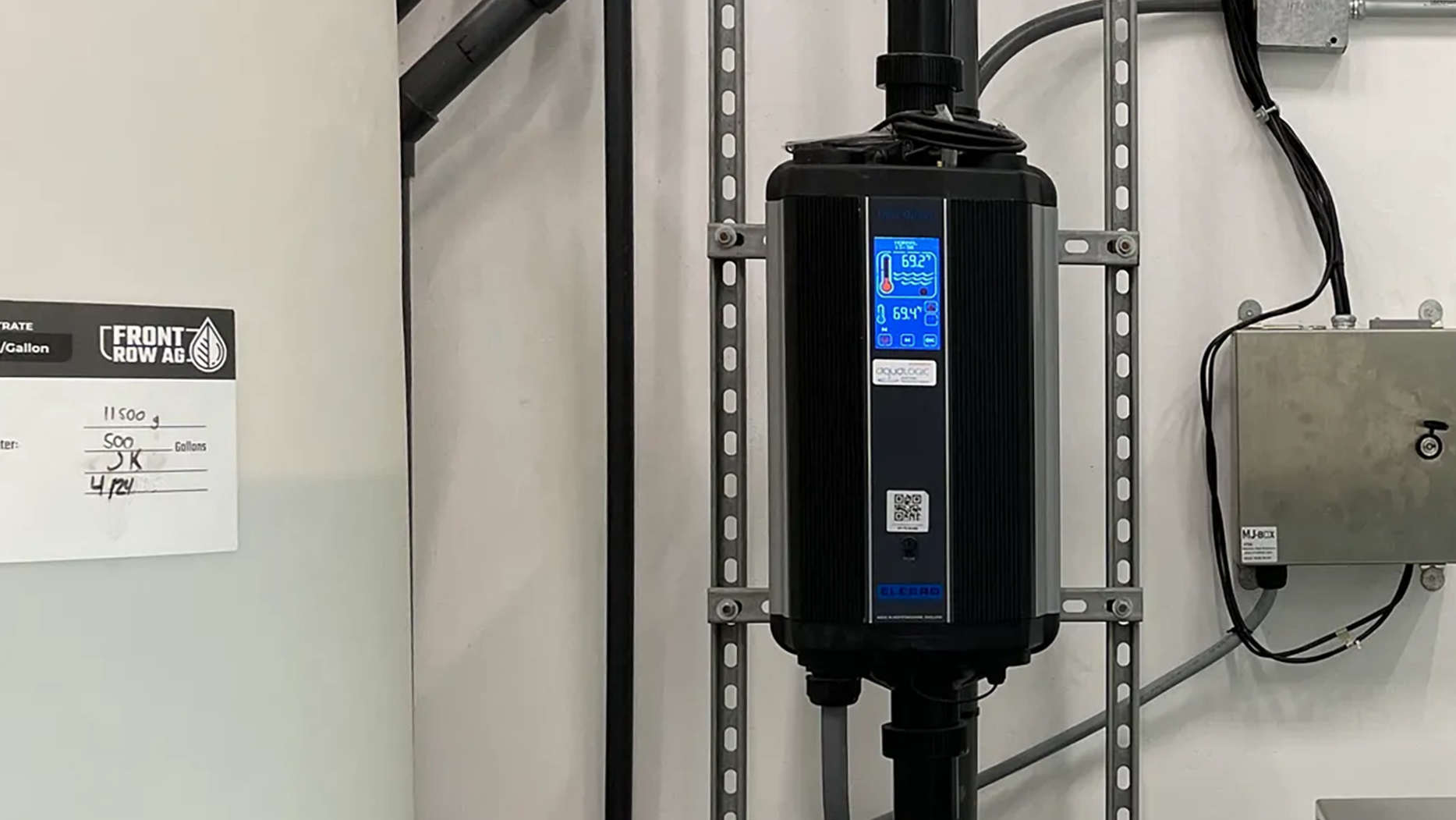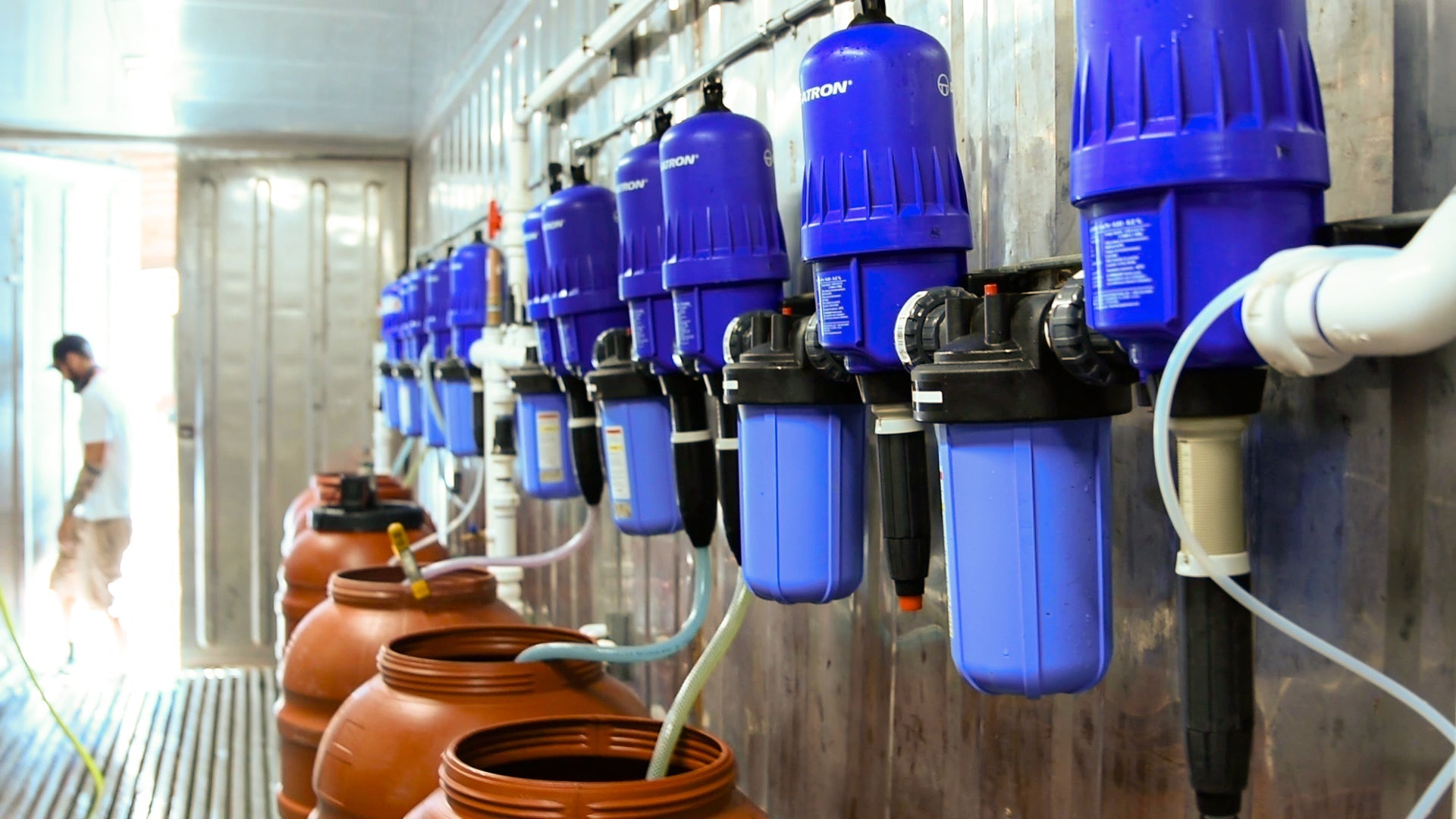Introduction
In hydroponic cultivation, pH management directly impacts nutrient availability, root health, and ultimately, crop performance. This challenge becomes particularly acute in facilities using reverse osmosis (RO) or very low EC water sources, where maintaining stable pH levels requires regular base addition. While potassium hydroxide (KOH) has been the traditional choice for pH adjustment, its aggressive chemical nature introduces significant operational risks - from handling hazards to system damage through mineral precipitation when injection or dilution isn't perfectly controlled.
Potassium carbonate (K₂CO₃) offers a fundamentally different approach to pH management. As a moderate-strength base with inherent buffering capacity, it provides both pH adjustment and stability while minimizing the risks associated with stronger bases. Front Row pH Up, a professional-grade potassium carbonate supplement, exemplifies this advanced approach to pH management - delivering safer, more reliable nutrient solution maintenance while protecting system components and optimizing nutrient availability.
This technical guide examines the chemical principles, practical benefits, and implementation methods that have made potassium carbonate the preferred choice for pH management in professional hydroponic facilities.
The Chemistry of Potassium Carbonate

Let’s look at how potassium carbonate exerts both it’s pH increasing and stabilizing effects:
Initial pH Adjustment:
When potassium carbonate dissolves in water, it triggers a cascade of chemical reactions that gradually increase solution pH:
-
Primary Dissociation: K₂CO₃ → 2K⁺ + CO₃²⁻
- The potassium carbonate (K₂CO₃) dissociates into potassium (K⁺) and carbonate (CO₃²⁻) ions.
- Potassium becomes available for plant nutrition
- Carbonate drives pH adjustment
-
Hydrolysis Reaction: CO₃²⁻ + H₂O ⇌ HCO₃⁻ + OH⁻
- Water hydrolyzes (splits) the carbonate ions, producing bicarbonate (HCO₃⁻) and hydroxide (OH⁻).
- OH- ions increase the pH
- Bicarbonate provides buffering
-
pH Increase: H⁺ + OH⁻ → H₂O
- These hydroxide ions directly increase the pH of the solution. As you'll recall from our previous articles on pH management, hydroxide ions are the principal ions that raise pH: the hydroxide ions react with the H+ ions present in solution and this “soaking up” of H+ ions is what increases the pH, producing a byproduct of pure water (H₂O).
-
Secondary Buffer Reaction: HCO₃⁻ + H⁺ ⇌ H₂CO₃ ⇌ CO₂ + H₂O
- So far, the pH has increased and we have water, bicarbonate, and (depending on the pH) possibly some unreacted carbonate still present. If the solution was fairly acidic to start, then bicarbonate will continue to raise the pH by soaking up additional H+ ions, creating carbonic acid (H₂CO₃), which exists in solution as dissolved carbon dioxide (CO₂), and water (H₂O)
💡 Review: Potassium Carbonate's pH-Increasing Steps:
|
The Carbonate Buffer System
The real advantage of potassium carbonate is it’s ability to resist pH changes once target levels are achieved. This buffering system operates through a dynamic equilibrium between three species; carbonate, bicarbonate, and dissolved CO₂. Let's look at how the system handles both acidic and basic challenges:
CO₂ ⇌ HCO₃⁻ ⇌ CO₃²⁻
The relative concentrations of these species depend on solution pH:
- Below pH 6.4: Primarily CO₂
- pH 6.4-10.3: Primarily HCO₃⁻
- Above pH 10.3: Primarily CO₃²⁻
In typical hydroponic conditions (pH 5.5-6.5), this system responds to pH changes as follows:
When Acids are Added:
-
Carbonate neutralization: CO₃²⁻ + H⁺ → HCO₃⁻
- Any remaining carbonate ions neutralize H⁺ ions and form bicarbonate. For example, when plants take up sulfate (SO₄²⁻), they release H⁺ ions - these H⁺ ions are neutralized by the carbonate.
-
Bicarbonate neutralization: HCO₃⁻ + H⁺ ⇌ CO₂ + H₂O
- Simultaneously, bicarbonate ions provide a second layer of protection by neutralizing additional H⁺ ions, forming dissolved CO₂ and water.
When Bases are Added:
-
CO₂ reaction: CO₂ + H₂O ⇌ HCO₃⁻ + H⁺
- The system can also resist pH increases. For example, when plants take up nitrate (NO₃⁻), they release OH⁻ ions in exchange. The dissolved CO₂ can react with water to release H⁺ ions that neutralize this OH⁻, forming bicarbonate.
-
Bicarbonate conversion: HCO₃⁻ ⇌ CO₃²⁻ + H⁺
- Similarly, bicarbonate can release H⁺ ions to neutralize OH⁻, forming carbonate in the process.
This buffering mechanism is particularly good in hydroponic systems because:
- It automatically counteracts pH changes from nutrient uptake
- Prevents sudden pH swings that could trigger nutrient precipitation
- Maintains optimal conditions for nutrient availability
- Reduces the frequency of pH adjustments needed
Understanding Buffer Capacity
The effectiveness of this buffer system depends on several factors:
- Total carbonate concentration
- Solution temperature (affects CO₂ solubility)
- Starting pH
- Water alkalinity
- Nutrient solution EC
This carbonate-bicarbonate system acts like a chemical shock absorber. By having species that can readily accept or donate protons (H+), the solution naturally resists drastic pH shifts. Instead of sudden, extreme changes that could precipitate nutrients out of solution or stress plant roots, potassium carbonate's buffering ensures that pH adjustments are steady and manageable. This stable chemical environment supports healthier root development, more consistent nutrient availability, and smoother day-to-day hydroponic operation.
This buffering effect is particularly valuable in hydroponic systems because nutrient uptake by plants naturally causes pH fluctuations. When plants absorb nutrients, they release ions that can shift root zone pH. The bicarbonate buffer system helps counteract these shifts, reducing the frequency of pH adjustments needed and maintaining more consistent nutrient availability.
This buffering system becomes particularly important when we consider the chemistry of nutrient precipitation - one of the most common and costly problems in hydroponic systems.
Precipitation: The process where dissolved ions combine to form solid compounds that "fall out" of solution. In hydroponics, precipitation makes nutrients unavailable to plants and can physically clog irrigation systems.
The risk of precipitation is particularly acute with strong bases like potassium hydroxide because they create localized zones of extremely high pH. These "hot spots" of high pH, even if temporary, can trigger a cascade of precipitation reactions that damage system components and reduce nutrient availability.
Managing Nutrient Precipitation Risk
Understanding and preventing nutrient precipitation is crucial for maintaining system health and nutrient availability. The risk of precipitation increases significantly when pH adjustment creates localized zones of high pH - a common issue with strong bases like KOH. Let's examine the chemical mechanisms of precipitation and how potassium carbonate's properties help prevent these issues.
Precipitation Mechanisms
Precipitation occurs when dissolved ions combine to form insoluble compounds, typically triggered by sudden pH changes. The most common precipitation reactions in hydroponic systems include:
- Iron hydroxide - Forms rusty orange-brown, fluffy precipitate that tends to settle as a loose layer
- Calcium phosphate - Creates chalky white deposits that form hard, crusty layers on surfaces
- Manganese hydroxide - Shows up as dark brown to black particles that can form a fine, powdery coating
- Zinc hydroxide - Presents as a white, gelatinous precipitate that tends to form cloudy suspensions before settling
Prevention Through pH Control
Potassium carbonate's buffered pH adjustment helps prevent precipitation through several mechanisms:
-
Gradual pH Changes
- Slower hydroxide release prevents localized pH spikes
- Allows mixing before significant pH change occurs
- Reduces risk of temporary high-pH zones
- Maintains more uniform solution conditions
-
Buffer Protection
- Carbonate/bicarbonate equilibrium resists sudden pH changes
- Helps maintain pH below critical precipitation thresholds
- Provides stability during nutrient additions
- Reduces impact of injection timing variations
-
Improved Mixing Dynamics
- Lower initial pH impact allows better distribution
- Reduces risk of precipitation at injection points
- More forgiving of injection sequence variations
- Better compatibility with hard water sources
Key Benefits of Potassium Carbonate
The chemical properties of potassium carbonate translate into several practical advantages that make it the superior choice for pH management in modern hydroponic facilities. These benefits span operational safety, system maintenance, ease of use, and ultimately, plant health.
Operational Safety and Handling
The safety advantages of potassium carbonate manifest in several ways:
- Reduced PPE requirements for routine pH adjustments
- Lower risk during spills or accidental exposure
- Safer storage conditions with minimal special requirements
- Reduced training burden for staff handling pH management
System Maintenance and Longevity
The buffered nature of potassium carbonate provides benefits for irrigation system maintenance:
-
Reduced Precipitation: The gradual pH changes prevent the formation of mineral deposits that frequently occur in systems using strong bases, leading to:
- Fewer clogged emitters and drip lines
- Extended filter life
- Reduced maintenance frequency
- More consistent flow rates
-
System Stability: The built-in buffering capacity means:
- Less frequent pH adjustments needed
- More stable nutrient availability
- Reduced risk of pH-related system failures
Ease of Use and Flexibility
Potassium carbonate's forgiving nature simplifies pH management operations:
This flexibility allows facilities to:
- Choose their preferred application method based on their specific needs
- Adjust pH management protocols with minimal risk
- Train new staff more quickly and confidently
- Maintain consistent pH levels with less intensive monitoring
Plant Health Benefits
While the operational benefits are compelling on their own, the stable pH environment created by potassium carbonate also supports optimal plant health:
-
Nutrient Availability: The buffered pH stability ensures more consistent nutrient availability by:
- Preventing sudden pH swings that can lock out essential elements
- Maintaining optimal conditions for nutrient uptake
- Reducing stress on root systems
-
Root Zone Health: The gentler pH adjustment process helps maintain a healthy root environment by:
- Preventing caustic damage to root tissues
- Supporting beneficial microorganism populations
- Reducing salt stress from mineral precipitation
These benefits compound over time, as the reduced maintenance requirements and increased system reliability allow cultivators to focus more on optimization and less on troubleshooting pH-related issues.
Practical Application
The effectiveness of potassium carbonate in pH management depends on proper application methods and understanding its unique characteristics. This section provides detailed guidance for implementing potassium carbonate in your cultivation facility.
Understanding Usage Rates
Potassium carbonate typically requires between 0.05 and 0.2 grams per gallon of nutrient solution for optimal pH adjustment. However, the exact amount needed will depend on several factors:
- Starting water quality and EC
- Target nutrient solution EC
- Desired final pH
- Specific fertilizer formulation used
Application Note: The most common mistake in potassium carbonate application is adding more before the initial dose has taken full effect. Remember that pH changes occur gradually over 10-15 minutes as the carbonate-bicarbonate buffer system establishes equilibrium.
Determining Your Optimal Rate: The Bucket Test
Before implementing potassium carbonate in your full system, conducting a bucket test allows you to precisely determine your facility's specific requirements. Here's a step-by-step guide:
-
Preparation
- Fill a 5-gallon bucket with your standard nutrient solution (mixed to target EC)
- Ensure solution is thoroughly mixed but not pH adjusted
- Have an accurate scale ready for measuring small amounts
-
Testing Process
- Add potassium carbonate in increments of 0.25 grams (equivalent to 0.05 g/gal for 5 gallons)
- Mix thoroughly after each addition
- Wait 15 minutes for full equilibration
- Measure and record pH
- Repeat until target pH is reached
-
Calculations
- Total grams used ÷ 5 gallons = grams per gallon required
- This becomes your baseline application rate
Document your results carefully. The relationship between amount added and pH change may not be linear, and this information can be valuable for future adjustments.
It's important to do a bucket test because severe over-application of potassium carbonate that raises the pH above 7.5 can lead to precipitation reactions.
Application Methods
Potassium carbonate offers flexibility in application methods, accommodating both manual and automated approaches:
Direct-to-Reservoir Application
- Can be added directly in powder form
- Ensure thorough mixing
- Allow 15 minutes before measuring final pH
- Make additional small adjustments if needed
Automated Injection
- Position pH Up injector last in sequence
- Monitor pH at emitter rather than immediately after injection
- Avoid over-application
- Stock solution concentration rates:

Monitoring and Adjustment
Once you've established your base rate through bucket testing, ongoing management becomes straightforward:
-
Regular Monitoring
- Check pH at the emitter, not directly after injection
- Allow sufficient time for pH stabilization
- Document any trends in pH drift
- Avoid overshooting pH
-
Making Adjustments
- Start with small changes to injection rates
- Wait at least 15 minutes before evaluating results
- Consider seasonal variations in water quality
- Monitor EC alongside pH for complete solution management
Troubleshooting Tips
To avoid any issues with using potassium carbonate, remember to:
- Avoid overshooting the pH, do a bucket test to determine your initial requirement
- After each addition, allow sufficient adjustment time before measuring
- Use the minimum amount necessary to achieve target pH
- Inject last in sequence
- Only use with low EC or RO water that requires pH increase
- Do not use with hard water or solution requiring pH decrease. High concentrations of calcium and magnesium in hard water can react forming insoluble carbonates.
Remember that potassium carbonate's buffering capacity means that once you've established the correct baseline rate, the system should require minimal adjustment. Significant deviations from established patterns often indicate other system issues that should be investigated.
Conclusion
The key advantages of potassium carbonate—its built-in buffering capacity, gradual pH adjustment, and reduced precipitation risk—directly address the most common challenges in hydroponic pH management. For facilities using RO or low EC water, these benefits yield clear operational improvements:
- Reduced system maintenance
- Increased worker safety
- More stable growing conditions
- Greater operational reliability
- Simplified pH management protocols




